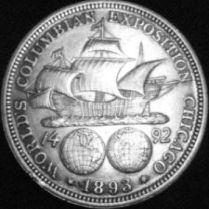 What I ran into was some nice silver coins that the seller knew the value of and had them priced a little over their true value based on the current spot silver price. There were some Roosevelt dimes and Standing Liberty quarters in fair condition but what caught my eye was the coin you see at left - the first U.S. commemorative coin. Officially called the World's Columbian Exposition Half Dollar, this coin features the bust of Christopher Columbus on the obverse with the image of his flagship, the Santa Maria above two
What I ran into was some nice silver coins that the seller knew the value of and had them priced a little over their true value based on the current spot silver price. There were some Roosevelt dimes and Standing Liberty quarters in fair condition but what caught my eye was the coin you see at left - the first U.S. commemorative coin. Officially called the World's Columbian Exposition Half Dollar, this coin features the bust of Christopher Columbus on the obverse with the image of his flagship, the Santa Maria above two  hemispheres, on the reverse. A total of 950,000 were minted with a 1892 date and 1,550,405 were minted with the 1893 date so they are not especially valuable. This 90% silver coin is considered to contain .3575 troy ounces of silver if circulated and is worth approximately one and a half times it's intrinsic (silver melt) value if the wear marks are minimal. If uncirculated, this coin contains .3617 troy ounces of silver and can be worth several hundred dollars in the higher Mint state grades of MS65 or higher. I didn't get a deal on it but paid less than $20 and am happy to get the first commemorative coin that the U.S. issued.
hemispheres, on the reverse. A total of 950,000 were minted with a 1892 date and 1,550,405 were minted with the 1893 date so they are not especially valuable. This 90% silver coin is considered to contain .3575 troy ounces of silver if circulated and is worth approximately one and a half times it's intrinsic (silver melt) value if the wear marks are minimal. If uncirculated, this coin contains .3617 troy ounces of silver and can be worth several hundred dollars in the higher Mint state grades of MS65 or higher. I didn't get a deal on it but paid less than $20 and am happy to get the first commemorative coin that the U.S. issued.Now onto the subject of The Last US 90 Percent Silver Coins...
Back when I was selling gold and silver for a large precious metals dealer in the midwest, it was not unusal to receive calls from individuals who had inherited a number of coins for which they hadn't the slightest idea of their worth and wanted help. With the large variety of old US gold and silver coins, it is no wonder the average person is confused as to their value.
And again, I am aware of more than one situation where finders of old silver coins took them to their local bank to convert them into the only money they were familiar with - paper (fiat) money, thereby allowing the bank to cash in on the silver profits that should have rightfully been theirs. Too many people don't understand the true value of pre-1965 US silver coins.
Finally, in my last encounter with a traveling buyer of gold and silver (who had set up shop at a local motel for 2 days), he mentioned that he was buying Morgan and Peace silver dollars for $15 apiece. The average person bringing in some silver dollars were probably thrilled with that price. The problem is who ever brought in silver dollars to this buyer should have been getting more like $21 or $22 each based on the spot silver price at the time. He was screwing them out of about $7 per coin.
So I decided to write a quick reference book to counter the lack of knowledge about pre-1965 silver coins. Titled "The Last US 90 Percent Silver Coins" it is now available on Amazon.com as an eBook for the various flavors of Kindle plus iPad, iPhone, PC, Mac, Android, BlackBerry or Windows Phone 7 with a free Kindle Reading App.
Priced at under $4 it has in-depth information on the Roosevelt Dime (1946-1964), Mercury Dime (1916-1945), Washington Quarter (1932-1964), Standing Liberty Quarter (1916-1930), 1964 Kennedy Half Dollar, Franklin Half Dollar (1948-1963), Walking Liberty Half Dollar (1916-1947), Peace Dollar (1921-1933) and Morgan Dollar (1878-1921). You will find it at The Last US 90 Percent Silver Coins if you want to take a free look at the table of contents plus the first chapter to see if it is right for you. I plan on expanding it in 2013.
At the time of this post spot silver is at $34.24. up $2.08 (6.48%) in the last 30 days and $3.19 (10.30%) in the last year. So far in November the U.S. Mint has produced 3,059,500 Silver Eagles which is 32,007,500 year-to-date. They should be able to top the 2010 total of 34,662,500 but it will take some doing to top the Silver Eagle total for 2011 of 39,868,500.
Silver has made some nice moves up since the election and it would be nice to see that continue.
Thanks for reading - keep the faith.



